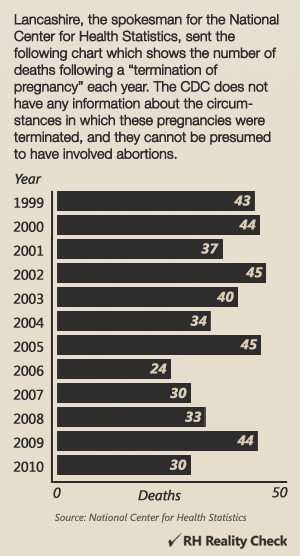Centers for Disease Control Data Do Not Support Anti-Choicers’ ‘Born Alive’ Claims
Jill Stanek, one of the nation’s most prominent anti-choice campaigners, has again made demonstrably incorrect claims about abortion, according to data from the Centers for Disease Control.

See other pieces from Rewire‘s State of Abortion series here.
Review the database of state documents collected and analyzed by Rewire here.
Jill Stanek, one of the nation’s most prominent anti-choice campaigners, has again made demonstrably incorrect claims about abortion, according to the U.S. Centers for Disease Control and Prevention (CDC).
In a post in which she took issue with an Rewire story co-authored by this reporter, Stanek claimed that in 2003, 77 viable fetuses had been “born alive” following an abortion and then killed by doctors.
In fact, as we have previously reported, documents provided by state attorneys general to members of the House Judiciary Committee show that there is no national pattern of fetuses “surviving” or being “born alive” after an abortion, much less being killed by health-care providers. That notion is a myth perpetuated by anti-choice extremists as they seek to win public support for measures that would restrict, or even abolish, access to safe abortion care.
But it’s worth unpacking the CDC numbers cited by Stanek, because they highlight the difficult realities faced by women and their health-care providers across the United States every day.
In making her claim, Stanek relied on CDC data from 1999 to 2010 reported under what the public health agency calls “code P96.4 – Termination of Pregnancy.”
Under that code, the CDC collects information from infant death certificates as part of the National Vital Statistics System, which includes all 50 states and the District of Columbia.
To be included in this code, a death must have resulted from a “termination of pregnancy,” but contrary to Stanek’s assertion, that is not a synonym for abortion. In fact, included in this number are pregnancies that have ended—or “terminated”—due to any number of circumstances, according to Jeff Lancashire, a spokesperson for the CDC’s National Center for Health Statistics.
“The fact is that based on the death certificates we know nothing else about the circumstances—such as how long the baby was alive—or about the procedure and why it was performed,” Lancashire wrote in an email to Rewire. “There is no way to conclude how many deaths are from what are commonly known as abortions and how many are from procedures prompted by medical emergencies. Nor do we have any other detail on the circumstances.”
The types of medical emergencies that could result in an ending of pregnancy within this definition include some of the most heart-wrenching situations faced by women and their partners, according to abortion providers who spoke with Rewire. Due to the sensitive nature of the topic, Rewire agreed to withhold their identities.
A New York abortion provider said that some terminations occur in cases when something goes wrong with a pregnancy that is very much wanted, such as when a woman goes into premature labor.
“A few months ago, a woman had twins, and they were 23 weeks and four days’ gestation. The woman wanted everything done for the babies,” the provider said. “Even though the NICU [neonatal intensive care unit] at the hospital was superb, both of the babies died. So it’s not that people were trying to abort the pregnancy. In fact, people were trying to do everything to save the babies, but they were just too immature to be saved.” These are among the kinds of circumstances included in the CDC data.
The provider also said there are circumstances in which a woman’s health is deteriorating so rapidly that she would likely die unless her pregnancy is terminated. He recalled the case of a woman who at 20 weeks’ gestation had developed a tumor in her brain stem.
“The neurosurgeon said that tumor was responding to the [pregnancy] hormones, and the husband could see the deterioration in his wife. She was going blind,” the provider said. “The maternal-fetal doctors [at the hospital] said that she might have to carry the fetus another six to eight weeks for it to be born alive. The neurosurgeon said that if she waited another six weeks to remove the tumor, she and the baby would be dead.”
 At 20 weeks’ gestation, the woman’s fetus had not yet reached a point where it had any chance of survival. After consultations between the neurosurgeon and the maternal-fetal medicine doctor, the woman chose to have an abortion.
At 20 weeks’ gestation, the woman’s fetus had not yet reached a point where it had any chance of survival. After consultations between the neurosurgeon and the maternal-fetal medicine doctor, the woman chose to have an abortion.
However, if the patient’s tumor had developed later in her pregnancy, doctors could theoretically have tried to save the baby, despite very low chances of its survival. That is another type of scenario that could result in a neonatal death after a “termination of pregnancy,” according to the provider—cases when the pregnancy must be terminated during the twilight zone between about 23 and 26 weeks’ gestation, when it is theoretically possible to deliver a live baby, but the chances of survival for longer than a few minutes are extremely low. Live deliveries at this extremely premature stage also put the baby at great risk of suffering life-long disabilities that the provider, who has been in practice for 40 years, described as potentially “horrendous.”
But the provider was at pains to point out that federal law requires physicians to care for a newborn, regardless of the circumstances of the birth, the age of the fetus, or the chances for success of saving a baby born so prematurely.
“If the mother wants everything to be done to save the baby, then everything will be done. Everyone is going to try to keep the baby alive,” the provider said.
“Even if you make attempts to keep it alive, you’re probably not going to be successful, but the attempts have to be made.”
Physicians are also required to try to save a baby in the theoretical situation that it is delivered alive in the course of an abortion. None of the providers interviewed by Rewire had ever witnessed a birth in those circumstances—and most take precautions to avoid such a result—but they said it could theoretically occur if, for instance, a woman went into labor before drugs used to ensure fetal demise had properly taken effect. Such late abortions are extremely rare, accounting for around 1 percent of terminations, and frequently involve a complication that seriously threatens the health of the women, the fetus, or both.
“Apart from Gosnell, I don’t think there is anyone who wouldn’t do everything for that baby,” the provider said. “That’s what would be required legally, and ethically.”
Indeed, the responses from state attorneys general to a recent congressional inquiry overwhelmingly indicated that doctors who failed to care for newborns could face criminal penalties, including murder charges, even if the newborn had no realistic chance of surviving for more than a few hours. States other than Pennsylvania have found no such prosecutions, indicating that Kermit Gosnell—who has been convicted of three counts of murder and one count of manslaughter—truly was a rogue.
In addition to misrepresenting the nature of the CDC data, Stanek greatly exaggerated the numbers she used in her post. (Stanek did not respond to requests for comment for this story.)
According to the CDC data, there have not been more than 45 babies who died shortly after a pregnancy was terminated in any year since 1999, the earliest year for which data were provided. The average was around 37 such deaths each year. Again, the CDC said it has no information about the circumstances that led to the termination of these pregnancies.
For the year Stanek referenced—2003—there were 40 neonatal deaths recorded after a termination of pregnancy. Stanek arrived at the number 77 by combining that figure with another number, which also does not give enough specificity to draw meaningful conclusions about the specific circumstances of these deaths.
This is not the first time that Stanek has made incorrect statements about the issue of infants who are purported to have been “born alive” after an abortion. In 2008, she was outspoken in condemning then Illinois state Sen. Barack Obama’s voting record on the “Born Alive Infants Protection Act,” a state bill that Obama believed was intended to undermine the U.S. Supreme Court’s decision in Roe v. Wade.
The furor arose in the midst of the 2008 presidential campaign, with anti-choice campaigners accusing candidate Obama of supporting feticide and of lying about his voting record—or at least, in Stanek’s case, implying that he might have lied—and that he refused to support a law that would require doctors to try to save a baby born alive after an abortion.
Obama explained that he had objected to the bill because he saw it as unconstitutional, and because Illinois law already required physicians to care for babies born after a pregnancy had been terminated.
After the furor, Stanek conceded in an interview with the Chicago Tribune that she had been wrong in characterizing Obama’s stance on the law. Yet she has continued her technique of misrepresenting evidence to make false claims relating to abortion, with the intent of winning public support for her ultimate aim: to ban all abortion, as she conceded in a recent Twitter conversation with staffers at Rewire.

